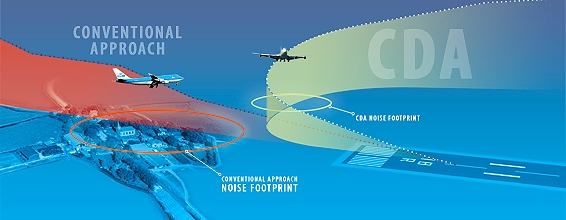Continuous Descent Approach (CDA) is one measure designed to curb air traffic emission levels in Europe. Aircraft using this procedure make a steady gliding approach to the runway from considerable height, preferably without any intervention from air traffic control. Because the engines of aircraft in gliding mode require less thrust than during customary approach procedures, they emit less CO2. CDA has already proved moderately successful at Schiphol, with some aircraft already making a gliding approach. However, this procedure has so far only been used at night, when there is less traffic and CDAs can be more readily facilitated in landing schedules. But even at night, two flights may approach simultaneously, which means air traffic control has to intervene, making an inefficient approach inevitable.
In 2011, NLR took a leap forward in the implementation of the gliding approach landing within the framework of the European AIRE programme (Atlantic Interoperability Initiative to Reduce Emissions), which is part of the SESAR programme. In close collaboration with KLM Royal Dutch Airlines and Air Traffic Control the Netherlands (LVNL), NLR developed a procedure and corresponding technology for managing the coordination of night flights. The basic idea is that approaching aircraft are instructed to adapt their speed slightly even before they initiate their glide, thus averting any simultaneous arrivals. The system makes optimum planning possible by using radio and satellite links to collect data from the aircraft’s onboard computer. The same uplink is used to share the modified landing schedule with approaching flights, thus ensuring that they reach the airport at the prescribed time. This enables a higher percentage of aircraft to execute CDA successfully. Tests with night flights performed over several weeks in 2011 confirmed the potential value of this technology.
The reduction of CO2 emissions is a spearhead of European policy towards more sustainable air transport. NLR is contributing to this effort by researching more eco-friendly gliding approach landings

